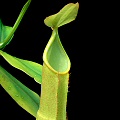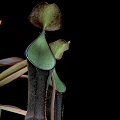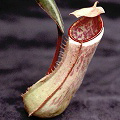| Peninsular Malaysian species | |
|---|---|
| Highlanders | Highland-lowland |
|
N. alba1 N. gracillima1 |
N. albomarginata2 N. ampullaria3 N. gracilis4 N. macfarlanei N. mirabilis5 N. rafflesiana6 N. ramispina1 N. sanguinea7 |
| Lowland | |
|
N. benstonei |
|
|
1Some botanists merge N. alba and N. ramispina into N. gracillima. 2Also in Borneo, Sumatra. 3Also in Borneo, Maluku, Sumatra, Thailand, Singapore, New Guinea. 4Also in Borneo, Singapore, Sulawesi, Sumatra, Thailand. 5Also in Australia, Borneo, China, Hong Kong, Indo-China, Java, Macau, Maluku, New Guinea, Palau, Philippines, Sulawesi, Sumatra, Thailand. 6Also in Borneo, Sumatra, Singapore. 7Also in Thailand. |
|
Q: Nepenthes: species of Peninsular Malaysia
A: Malaysia consists of two main land-masses. East Malaysia consists of its presence on
Borno, which I already talked about a few FAQ pages ago. West Malaysia, here referred to as
Peninsular Malaysia, is separated from Borneo by the South China Sea, is bound to the north by Thailand and is
terminated at the south by Singapore.
(By the way, Singapore's set of pitcher plants consist of a subset of Peninsular Malaysia's, i.e.
Nepenthes ampullaria, N. gracilis, and N. rafflesiana.)
Most of the species in Peninsular Malaysia occur elsewhere; only five species are endemic.
Nepenthes benstonei
Noteworthy in regularly producing multiple inflorescences simultaneously, and
also in its very thick, glossy cuticle; however, such characters have been observed in other species.
Known only from the type locality in Kelantan, although additional
collections suggest it may occur elsewhere. Originally described in 2001 by Cheek & Jebb, this description included Thai plants.
Clarke defined the plant more narrowly; the Thai plants were later described as an entirely new species,
Nepenthes thai.
Nepenthes gracillima
This species is closely related to N. alba
and N. ramispina, and there
is much lively debate (read spitting contests) about whether they should be considered separate species. In general terms,
N. gracillima is a smaller version of N. ramispina with commensurately
small or less developed features. But really, refer to Clarke (2001) for a complete discussion.
Nepenthes gracillima and N. alba are restricted to the Tahan Range
and other nearby mountains--read McPherson's contributions to see the rationale behind maintaining these as two
separate species.
Nepenthes macfarlanei
A plant that has pitchers with hairs on the underside of the lid. Why these hairs
occur is unknown. Do they increase surface area to encourage the release of some compound? Are they some other kind of
attractant? This plant is
scattered throughout many sites in Peninsular Malaysia.
Nepenthes ramispina
A plant with really black pitchers that are, in my eyes, spectacular.
Found from a number of sites in the center of Peninsular Malaysia.
Nepenthes sanguinea
Although this species doesn't have a madly enlarged peristrome, it has a very graceful,
gently beautiful pitcher shape. A fairly forgiving plant that is good for the experienced novice. Distributed throughout
Peninsular Malaysia.
Page citations: Cheek, M.R., and Jebb, M.H.P. 2001; Clarke, C. 1997, 2001; Danser, B.H. 1928;
Jebb, M.H.P., and Cheek, M. 1997; McPherson, S. 2009a, 2009b;
Rice, B. 2006a; Schlauer, J. 2002.


